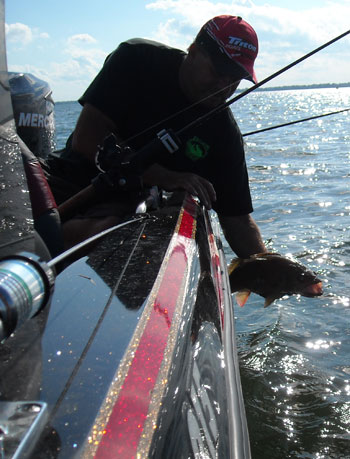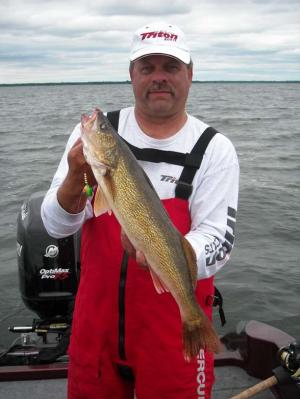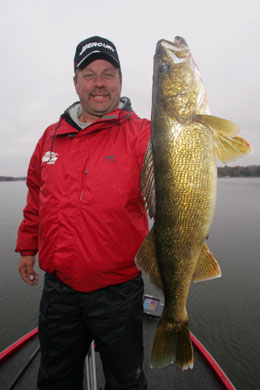If you spend enough time fishing for walleyes, you've probably had some August and September days that left you scratching your head. It could be because you haven't showered for several days. More likely, it's because the body of water you are fishing seems as unfamiliar as somebody else's boat. Sometimes, even fisheries you know better than your route to work pose more questions than they answer, especially during that late summer period when walleyes are somewhere between seasonal patterns.
 "So where did the fish go?" you ask as you consider everything from shallow and deep to mud and rock to sand and weeds." Maybe there's too much forage," you hypothesize, knowing full well that warm water means walleyes are feeding more frequently than they will at any other time of year. "What if it's just the time of day?" You ponder, although the bite wasn't any better at sunrise. "There aren't any fish left in this lake," you conclude, knowing full well how good the bite was a few months earlier in the spring.
"So where did the fish go?" you ask as you consider everything from shallow and deep to mud and rock to sand and weeds." Maybe there's too much forage," you hypothesize, knowing full well that warm water means walleyes are feeding more frequently than they will at any other time of year. "What if it's just the time of day?" You ponder, although the bite wasn't any better at sunrise. "There aren't any fish left in this lake," you conclude, knowing full well how good the bite was a few months earlier in the spring.
The fact of the matter is, there are always fish to be caught somewhere. In my 20 years of competitive walleye fishing, I have yet to see a day when everybody in the field zeroes. Somebody always manages to scratch up a limit. Whether you are venturing out on a new body of water or trying to solve the late-summer puzzle on one of your favorites, there are ways to tip the odds in your favor.
First of all, apply what you know about walleye behavior and biology. Seasonal patterns don't change, but they are related to forage and water temperature. It follows that if the body of water you are fishing is located in Canada or the upper Midwest, walleyes are probably farther along in their seasonal patterns than they are farther south.
Take into consideration recent weather patterns. Extended periods of scorching temperatures will likely keep walleyes in their summer pattern when they follow baitfish into layers of cooler, well oxygenated water like thermoclines. Lots of rain or wind that mixes the water can break up those layers of denser water and open the entire body of water to walleye activity. When air temperatures begin to dip into the 40s or even 30s at night, that's usually a sign that walleyes will soon be settling into more traditional fall patterns.
Ideally, you'll have some information to serve as a starting point. It could be from somebody who caught fish recently on a given body of water, or it could come from somebody you trust with previous experience at that location around the same time of year. I probably won't put all my eggs in any basket if the information comes from just a single source, but if two sources tell me the same thing and their experiences aren't related, that's information that will probably be valuable.
 Your own experiences are another valuable source of information. You probably know how walleyes behave somewhere in late August or September, and that can give you some basic information and ideas that will probably apply no matter where you are fishing. And with today's modern GPS and detailed, pre-loaded maps like my Humminbird 1197 offers, you can dissect a new body of water before you ever leave the boat landing to duplicate habitat, depth or seasonal migration patterns.
Your own experiences are another valuable source of information. You probably know how walleyes behave somewhere in late August or September, and that can give you some basic information and ideas that will probably apply no matter where you are fishing. And with today's modern GPS and detailed, pre-loaded maps like my Humminbird 1197 offers, you can dissect a new body of water before you ever leave the boat landing to duplicate habitat, depth or seasonal migration patterns.
Local bait shops can be helpful, too. Don't get entirely hung up on current information. Make sure you also ask what the bite is usually like this time of year, what areas are productive at what times of the year and what is the primary forage base. That's one of the best questions you can ask because it's like an aquatic buffet with young-of-the-year fish now at an edible size and abundant. Walleyes can pick off a meal almost anywhere, but the majority of them will choose the forage that's most readily available and either easy to catch or so dense they can't all escape an ambush. For example, if a lake has a huge perch population, you can be fairly confident that you will find a good number of walleyes hanging out with the smaller perch, probably in deep water. If it's an alewife forage base, you're probably looking at walleyes that will be following those baitfish out in open water. If it's emerald shiners, they'll eventually make a run into adjoining creeks and rivers and that could be a valuable clue once September arrives. If you know where those walleyes are eventually headed, many times you can backtrack and figure out where they will be coming from.
If I don't know much about a body of water, or when I'm struggling to catch fish on one of my old standbys, one of the first places I turn is to those feeder creeks or tributaries. If they've got any depth at all, they hold fish all year, but especially when fall is settling in. Check out the mouths of these feeder streams or rivers, then move on into them if you can. I also explore any main-lake points.
Because I'm usually in search mode at this point, the best way I know to determine if there are walleyes present is to graph an area with my Humminbird, then drop the Mercury 9.9 Pro Kicker and troll crankbaits on the flats, breaklines and up and down the points. If there's a weed edge present, I may slow down and put my MinnKota Terrova 101 bow-mount to work rigging smaller areas with leeches or crawlers. And if my Humminbird tells me the fish are tight to the bottom, I may even drift an area with jig-and-leech or jig-and-crawler combinations.
Earlier this summer, Anglers Insight Marketing (AIM) put a tournament on Lake Superior out of Brimley, Mich. About all most of us knew was that Brimley Bay held good numbers of big walleyes in the spring and fall. As for the rest of the year … most local anglers focus on other species like trout and salmon. The questions my teammates and I asked ourselves were these: What is it about Brimley Bay that holds walleyes in the spring and fall, do all the walleyes leave these areas during the summer, and are there any other areas with similar characteristics?
 We concluded that the only reason walleyes would prefer Brimley Bay was warmer water and the variety of baitfish it would hold as opposed to the frigid, 45-degree water in Lake Superior proper. Of course, we knew there were trophy fish out in the big lake because we'd heard of anglers catching them while trolling for trout and salmon, but we didn't believe there were Lake Erie-like schools of giant walleyes roaming around everywhere. Finding those small pods of big fish in all that water and staying on them for several days wasn't likely. So, we reasoned that other fish probably preferred the comfort of warmer, shallower water like Brimley Bay year-round.
We concluded that the only reason walleyes would prefer Brimley Bay was warmer water and the variety of baitfish it would hold as opposed to the frigid, 45-degree water in Lake Superior proper. Of course, we knew there were trophy fish out in the big lake because we'd heard of anglers catching them while trolling for trout and salmon, but we didn't believe there were Lake Erie-like schools of giant walleyes roaming around everywhere. Finding those small pods of big fish in all that water and staying on them for several days wasn't likely. So, we reasoned that other fish probably preferred the comfort of warmer, shallower water like Brimley Bay year-round.
Satellite imaging helped us find another area with nearly identical characteristics, and it was loaded with big walleyes. We also discovered a creek that was full of smaller walleyes that could help fill out a limit. That tournament provided a good lesson in applying some general walleye knowledge with some local information and using modern technology to expand and build on it. We all finished well in that tournament.
Ultimately, fish are where we find them, but they're always biting somewhere. I think a lot of times anglers miss walleyes even on their home bodies of water. They might be trolling lead-core when the fish are suspended. Or they might be working breaklines when the fish are cruising the shorelines.
These days, it seems like anglers are discovering new ways to catch walleyes all the time. I know I'm learning something new every day. Take advantage of your knowledge and experience. Seek out current and historical information. And don't be afraid to try something new and different. You might just be enlightened.










